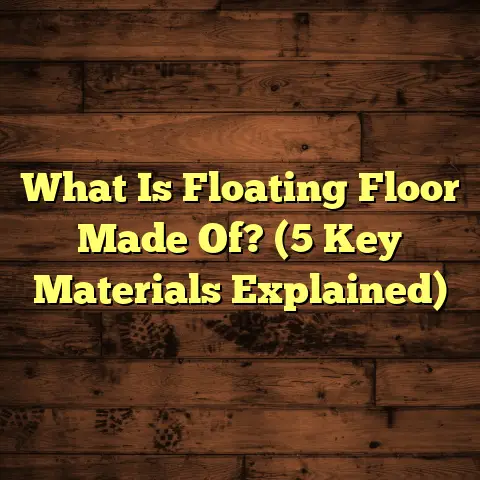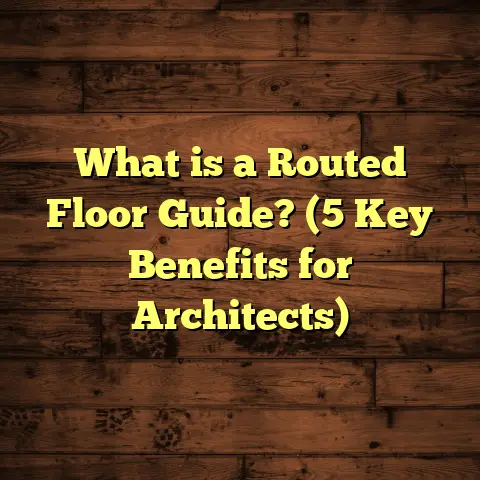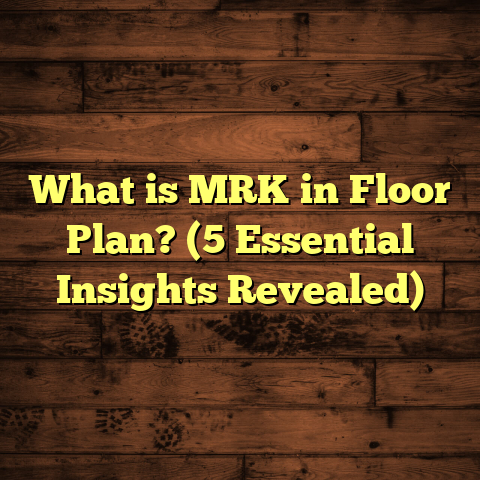What is More Expensive: Wood Floor or Carpet? (5 Key Cost Factors)
Hey, have you ever stood in a flooring store staring at endless options and wondered, “What’s going to cost me more over time — wood floors or carpet?” I’ve been there more times than I can count. Flooring isn’t just about picking a pretty surface; it’s about budgeting smartly for your home’s heart. Over the years, I’ve installed both wood and carpet in all sorts of homes, and I want to share what I’ve learned about the true costs behind these two popular choices.
Before you decide, let’s break down what each option really means to you — not just in upfront price but over the long haul.
What Is Wood Flooring and Carpet Flooring?
Wood flooring typically refers to planks made from solid hardwood or engineered wood. It’s known for its durability, timeless look, and ability to add value to homes. You might see options like oak, maple, cherry, or bamboo, each with unique grains and tones. Engineered wood has a plywood base with a thin hardwood veneer on top, offering more stability in humid spaces.
Carpet, on the other hand, is soft floor covering made from fibers like nylon, polyester, or wool. It comes in rolls or tiles and offers warmth and comfort underfoot. It’s often chosen for bedrooms and living rooms because of its cozy feel and sound-absorbing qualities.
Both have their place, but how do their costs stack up when you factor in installation, upkeep, and lifespan?
1. Material Costs: What’s Sitting on Your Floor?
Let’s talk dollars first. When I’m helping homeowners figure out budgets, material cost is usually the first hurdle.
Wood Flooring Material Prices
- Solid hardwood generally runs between $5 to $12 per square foot.
- Engineered wood ranges from $4 to $10 per square foot.
- Exotic woods like Brazilian cherry or teak can push past $15 per square foot.
- Bamboo flooring is often an affordable hardwood alternative at about $3 to $8 per square foot.
Material cost varies widely depending on wood species, grade, finish type (pre-finished vs. site-finished), and plank width. Wider planks tend to cost more due to higher material waste and manufacturing complexity.
Carpet Material Prices
- Basic nylon or polyester carpet can cost as little as $1 to $3 per square foot.
- Higher-end wool or stain-resistant carpets are around $4 to $7 per square foot.
- Specialty carpets with patterns or plush textures might go beyond $8 per square foot.
- Carpet padding adds $0.30 to $0.75 per square foot depending on quality.
When I first started installing flooring professionally, clients often assumed carpet was always cheaper. But I’ve seen cases where luxurious carpets with premium padding ended up costing almost as much as mid-grade wood floors — especially for large areas.
Why do material prices vary so much?
Wood prices fluctuate based on:
- Harvest availability
- Import tariffs
- Demand for sustainable or exotic species
Carpet pricing depends on:
- Fiber type (natural vs synthetic)
- Density
- Stain resistance treatments
Personal anecdote: A client once chose a high-end wool carpet for their living room because they loved the softness and natural fibers. The price was nearly $9 per square foot with padding — way above typical carpet costs but still less than some exotic hardwoods we priced out for them.
2. Installation Costs: Labor Can Surprise You
You might assume installation costs are straightforward, but they can vary widely depending on the complexity of the job and the type of flooring.
Wood Installation
Installing hardwood isn’t always quick. You often need:
- Subfloor preparation (which can be costly if your base isn’t level)
- Nailing or gluing planks down
- Finishing touches like sanding and sealing (for unfinished wood)
Labor rates average from $4 to $8 per square foot. In some cities, this might climb higher due to skilled labor demand.
Installation time varies by:
- Room shape complexity
- Floor condition
- Type of wood
- Installation method: nail-down, glue-down, or floating
For example, I recall a home where we had to repair the subfloor before laying oak planks because of water damage underneath. That prep work added days and several hundred dollars to labor.
Carpet Installation
Carpet installation tends to be quicker and less labor-intensive:
- Stretching the carpet properly
- Tack strips along edges
- Padding underneath (which adds to comfort but also cost)
Typical labor costs range from $1 to $3 per square foot, so it’s noticeably cheaper than wood.
You’ll pay extra if you need:
- Carpet removal
- Floor leveling before installation
- Special trimming around stairs or corners
Additional installation costs to consider:
- Moving furniture out of rooms
- Waste disposal fees for old flooring
A client once shared how they saved nearly $1,000 by moving all their furniture themselves before carpet installation — it’s a small thing that can make a difference if you’re budget-conscious.
3. Maintenance Over Time: What Will You Pay Later?
Now, this is where many people get surprised. The initial price tag is only part of the story; maintenance can swing total costs dramatically.
Wood Floor Maintenance
Wood floors need regular care:
- Sweeping/dry mopping weekly
- Occasional damp mopping with special cleaners
- Refinishing every 7-10 years to restore shine and protect the surface
Skipping refinishing leads to scratches and wear buildup. Refinishing costs between $2 to $5 per square foot depending on floor condition and area size.
Humidity control is crucial; too much moisture causes warping or cupping.
In my experience, clients who live in humid climates often invest in dehumidifiers alongside wood floors to keep moisture levels stable — adding ongoing energy costs but protecting their floor investment.
Carpet Maintenance
Carpet requires:
- Weekly vacuuming
- Professional deep cleaning once or twice a year ($0.20 to $0.50 per square foot)
- Spot treatments for spills and stains
Carpets trap dirt and allergens more than hard surfaces. If you have pets or kids, stains happen fast.
Vacuuming regularly extends carpet life but doesn’t replace professional cleaning needed every 12-18 months.
In homes with allergy sufferers, I’ve recommended carpet removal altogether because carpets harbor dust mites that can aggravate symptoms — something many don’t realize until years later.
4. Lifespan: How Long Will Your Flooring Last?
If you think about cost over 20 years rather than just upfront, lifespan becomes critical.
Wood Floors
Solid wood floors can last decades — 20 to 100 years if cared for properly. Engineered wood is less durable but still offers 15-25 years on average.
Hardwood floors can be sanded and refinished multiple times — each refinishing restoring their look and extending life by years.
For instance, a well-maintained oak floor in an older home I worked on was over 80 years old with original planks still solid under layers of refinishing.
Carpet
Most carpets last between 5 to 15 years before needing replacement due to wear, staining, or matting.
High traffic areas wear faster — hallways and stairs may need replacing earlier than bedrooms.
Some specialty carpets advertise longer lifespans (up to 20 years), but those usually come at premium prices.
Replacing carpet every decade means repeated material + installation costs over your home ownership — something not everyone budgets for upfront.
5. Resale Value and Home Appeal
Let me ask you: If you were buying a house, which flooring would catch your eye? Most buyers tend to prefer wood floors for several reasons:
- They feel cleaner
- Are easier to keep allergen-free
- Add a luxury look that carpets often don’t match
Homes with hardwood floors typically sell for 1% to 2% more than similar homes with carpeted floors. This may not seem huge at first glance but can mean thousands more on a house sale.
I had one client who switched from carpet to hardwood in their main living spaces before listing their home. They ended up with multiple offers above asking price — part of that was thanks to the upgraded flooring.
Additional Cost Factors That Affect Your Decision
Sometimes people forget there are other expenses buried in flooring projects.
Removal of Existing Flooring
Whether you’re tearing out old carpet or refinishing over an existing hardwood floor, removal costs add up.
Removing carpet runs around $0.50 to $1 per square foot plus disposal fees.
Old hardwood may require professional sanding instead of removal but damaged boards might need replacing — adding material costs.
Subfloor Repairs
Uneven or damaged subfloors add labor and materials costs regardless of new flooring choice.
Subfloor prep can add $2 to $5 per square foot if extensive repairs like leveling compound or plywood replacement are needed.
Environmental Impact & Sustainability Considerations
More people are thinking about eco-friendly choices now. This can influence your cost decision too.
Wood Flooring Sustainability
Wood is natural but harvesting impacts forests unless sourced responsibly.
Look for certifications like FSC (Forest Stewardship Council) which guarantees sustainable forestry practices.
Engineered wood uses less hardwood per plank but includes plywood layers treated with adhesives that may release VOCs (volatile organic compounds).
Bamboo is a fast-growing grass considered more sustainable than traditional hardwoods but varies by product quality.
Carpet Sustainability
Synthetic carpets are petroleum-based and not biodegradable, raising concerns over landfill waste after disposal.
Wool carpets are natural and biodegradable but usually pricier upfront.
Recycled fiber carpets exist too but may have lower durability or fewer style options.
If environmental impact matters to you, factor this into your decision beyond just price tags.
Regional Price Variations: Where You Live Matters
Costs vary significantly by location due to:
- Local labor rates
- Availability of materials
- Shipping distances
- Climate-related installation challenges
For example:
- Urban areas tend to have higher labor costs.
- Remote locations may face higher material prices due to shipping.
- Humid climates require moisture barriers under wood floors adding cost.
- Cold climates might favor carpet for warmth despite higher replacement frequency.
I’ve done projects coast-to-coast where the same hardwood floor cost 20% more in major cities than rural towns because labor was pricier there.
Personal Stories & Lessons Learned on Choosing Between Wood & Carpet
Over my years as a flooring contractor, I’ve seen clients make both great choices and costly mistakes based purely on initial price focus.
One family chose cheap carpet for their living room but quickly regretted it when stains from kids’ juice spills ruined the look within months. They ended up replacing it after just 3 years — paying double what they expected in the long run.
Another homeowner invested in mid-grade engineered wood throughout their house. They told me five years later it still looked brand new after regular cleaning and one refinishing — “worth every penny,” they said.
Comparing Comfort & Practical Use: How You Live Matters
Beyond dollars, think about how you use your space daily.
Wood Floors
Pros:
- Easy to clean spills quickly (great for kitchens)
- Hypoallergenic surface (no dust buildup)
- Adds elegance & brightness visually
Cons:
- Harder surface underfoot (might be less comfy standing long)
- Can be cold without rugs or underfloor heating
Carpet
Pros:
- Soft & warm underfoot (ideal for bedrooms)
- Good sound insulation (reduces echo)
- Safer fall surface for kids/elders
Cons:
- Traps dust & allergens (needs frequent vacuuming)
- Stains easily unless treated
- Can look worn faster in high traffic areas
I once installed carpet in a nursery room where parents loved the softness for crawling babies. But they switched it out a few years later after allergy symptoms flared — opting for wood with large washable rugs instead.
Budgeting Tips: How I Help Clients Manage Flooring Costs
When I work with homeowners trying to decide between wood and carpet, here’s my practical advice:
- Calculate total project costs: Include material + installation + removal + maintenance + lifespan replacements.
- Use tools like FloorTally: They factor local labor/material rates plus waste percentages so you get realistic estimates.
- Think about resale value: If selling soon, wood floors often pay off better.
- Consider room function: Mix flooring types if budget allows — wood in public areas, carpet in bedrooms.
- Factor personal lifestyle: Pets? Kids? Allergies? These affect maintenance needs.
- Shop smart: Look for sales/outlets on quality materials rather than cheapest brands that wear out fast.
- DIY some prep: Moving furniture or removing old flooring yourself saves cash if you’re handy.
- Plan for future upgrades: Sometimes paying more now saves thousands later down the road from replacements/refinishing.
Summary Table: Wood Floor vs Carpet Cost Breakdown Over 10 Years
| Cost Factor | Wood Floor (per sq ft) | Carpet (per sq ft) |
|---|---|---|
| Material | $5 – $12 | $1 – $8 |
| Installation | $4 – $8 | $1 – $3 |
| Removal | $0 – $1 | $0 – $1 |
| Maintenance | Refinishing + cleaning ~$0.30/year | Cleaning + spot treatment ~$0.50/year |
| Replacement | Rare (refinishing) | Every 7–10 years |
| Lifespan | 20+ years | 5–15 years |
| Resale Value Impact | +1–2% home value | Minimal |
Final Thoughts: Which Flooring Is Worth It For You?
If you want my honest opinion:
Choose carpet if:
- You want lower upfront cost
- Need soft warmth in bedrooms/playrooms
- Plan short-term home ownership (<10 years)
Choose wood if:
- You want durability & long lifespan
- Care about increasing home resale value
- Prefer hypoallergenic easy-clean surfaces
- Can invest upfront for long-term savings
Every home and budget is unique though — so don’t hesitate to get detailed quotes tailored for your exact needs through online tools or local pros like me!
If you want help calculating exact costs based on your home size and location, tools like FloorTally offer detailed estimates factoring local labor/material prices plus waste percentage — saving you time and guesswork.
Feel free to reach out if you want me to help crunch those numbers for your project!
Thanks for sticking with me through this deep chat about flooring costs! Which option feels right for your home now?





